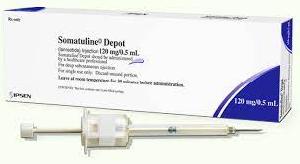Lanreotide Disease Interactions
There are 7 disease interactions with lanreotide.
- Hepatic impairment
- Renal impairment
- Thyroid abnormalities
- Adrenal insufficiency
- Bradycardia
- Cholelithiasis
- Diabetes
Lanreotide (applies to lanreotide) hepatic impairment
Moderate Potential Hazard, Moderate plausibility. Applicable conditions: Liver Disease
In clinical trials, a reduced clearance of lanreotide was observed in subjects with moderate to severe hepatic impairment. Patients with moderate to severe hepatic impairment should begin treatment with lanreotide 60 mg. Caution should be exercised when using this agent in patients with moderate or severe hepatic impairment for an extended dosing interval.
References
- (2007) "Product Information. Somatuline Depot (lanreotide)." Ipsen Inc
Lanreotide (applies to lanreotide) renal impairment
Moderate Potential Hazard, Moderate plausibility. Applicable conditions: Renal Dysfunction
Lanreotide has not been studied in patients with mild, moderate and severe renal failure. It is recommended to start patients with moderate and severe renal impairment at a lower dose as clinically appropriate.
References
- (2007) "Product Information. Somatuline Depot (lanreotide)." Ipsen Inc
Lanreotide (applies to lanreotide) thyroid abnormalities
Moderate Potential Hazard, Moderate plausibility. Applicable conditions: Thyroid Disease
Slight decreases in thyroid function have been seen during treatment with lanreotide. Care should be taken when using this agent in patients with thyroid dysfunctions and it is recommended to monitor thyroid function where clinically indicated.
References
- (2007) "Product Information. Somatuline Depot (lanreotide)." Ipsen Inc
Somatostatin analogs (applies to lanreotide) adrenal insufficiency
Moderate Potential Hazard, Moderate plausibility.
Treatment with somatostatin analogs may suppress the pituitary hormones other than GH/IGF-1. It is recommended to monitor pituitary function prior to initiation of therapy and periodically during treatment, as clinically appropriate. Patients should be monitored for and instructed on the signs and symptoms of adrenal insufficiency during therapy. If adrenal insufficiency is suspected it should be confirmed and treated per standard of care with exogenous glucocorticoids at replacement doses.
References
- (2007) "Product Information. Somatuline Depot (lanreotide)." Ipsen Inc
- (2013) "Product Information. Signifor (pasireotide)." Novartis Pharmaceuticals
Somatostatin analogs (applies to lanreotide) bradycardia
Moderate Potential Hazard, Moderate plausibility. Applicable conditions: Heart Disease, Hypothyroidism
Bradycardia has been reported with the use of somatostatin analogs. It is recommended to carefully monitor patients with cardiac disorders for the development of bradycardia. Dose adjustments of beta-blockers, calcium channel blockers, or correction of electrolyte disturbances may be necessary. Care should be taken when initiating treatment with these agents in patients with bradycardia.
References
- (2007) "Product Information. Somatuline Depot (lanreotide)." Ipsen Inc
- (2013) "Product Information. Signifor (pasireotide)." Novartis Pharmaceuticals
Somatostatin analogs (applies to lanreotide) cholelithiasis
Moderate Potential Hazard, Moderate plausibility. Applicable conditions: Gallbladder Disease
Somatostatin analogs may reduce gallbladder motility and lead to gallstones formation. It is recommended to assess the gallbladder prior to starting therapy and periodically thereafter.
References
- (2007) "Product Information. Somatuline Depot (lanreotide)." Ipsen Inc
- (2013) "Product Information. Signifor (pasireotide)." Novartis Pharmaceuticals
Somatostatin analogs (applies to lanreotide) diabetes
Moderate Potential Hazard, Moderate plausibility. Applicable conditions: Diabetes Mellitus
Elevations in blood glucose levels have been reported with the use of somatostatin analogs. Cushing's disease patients with poor glycemic control may be at a higher risk of developing severe hyperglycemia and associated complications, e.g., ketoacidosis. It is recommended to assess the glycemic status of hemoglobin A1C prior to starting treatment with these agents. Self-monitoring of blood glucose and/or FPG assessments should be done every week for the first two to three months and periodically thereafter, as clinically appropriate, as well as over the first two to four weeks after any dose increase. If uncontrolled hyperglycemia persists, despite appropriate medical management, the dose of these agents should be reduced or discontinued.
References
- (2007) "Product Information. Somatuline Depot (lanreotide)." Ipsen Inc
- (2013) "Product Information. Signifor (pasireotide)." Novartis Pharmaceuticals
Lanreotide drug interactions
There are 154 drug interactions with lanreotide.
Lanreotide alcohol/food interactions
There is 1 alcohol/food interaction with lanreotide.
More about lanreotide
- lanreotide consumer information
- Check interactions
- Compare alternatives
- Pricing & coupons
- Reviews (1)
- Side effects
- Dosage information
- During pregnancy
- Drug class: somatostatin and somatostatin analogs
- Breastfeeding
- En español
Related treatment guides
Drug Interaction Classification
| Highly clinically significant. Avoid combinations; the risk of the interaction outweighs the benefit. | |
| Moderately clinically significant. Usually avoid combinations; use it only under special circumstances. | |
| Minimally clinically significant. Minimize risk; assess risk and consider an alternative drug, take steps to circumvent the interaction risk and/or institute a monitoring plan. | |
| No interaction information available. |
Further information
Always consult your healthcare provider to ensure the information displayed on this page applies to your personal circumstances.


